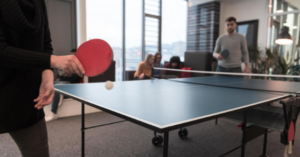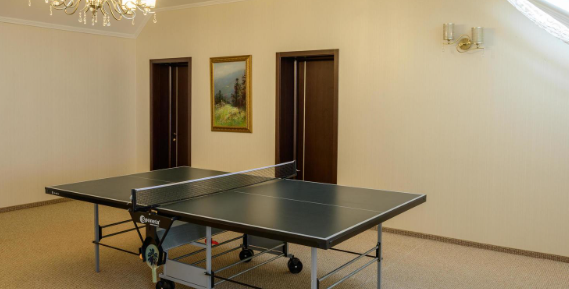Table Tennis Techniques
It may seem simple, but competitive table tennis is an extravagant dance of angles, spins, and strategic mind games – not just a battle of speed and reflexes. One of the key skills in this sport is surely the art of spin. If you play with good spin, you can become a better player at a higher level and even against the competition. In this article, we will go over some advanced Table Tennis Techniques, when to use them in competitive play, and how you can start implementing them in your game.
Between Tangible Spin vs. Surface and Type of Spin
What is Spin?
Sports definition Spin is the ball rotation, which causes into slice, hook, carob bounce unexpected directions. One of the biggest reasons that spin is so important in table tennis is that spin heavily controls how the ball flies, and how your opponent reacts to and plays/responses to the ball. Understanding the different types of spin is crucial to develop accurate Table Tennis Techniques.
- Topspin : a very high forward spins leading to a steep descent trajectory hence, aggressive shots with a quick dip and a high bounce
- Backspin: A low and relatively easily put away spin.
- Side spin: A spin on the side that will cause angles that are difficult to predict, making it harder for your opponent to read if the ball goes.
Moving on to more technical aspects involved in competitive play, the first one up to discuss is a widely debated topic and innovations regarding this are a game changer as you would read in the following.

Spin Better to Focus on During Competitive Play
Especially in more competitive play, spin can be the key to victory or defeat. It lets players set the pace of the game and can bait opponents into misplaying. Here are some of the reasons why learning how to spin is so critical:
- Massive: With a spin, players are able to control their shots well to place them wherever they want to.
- Misdirection: Different rotations can confuse enemies and throw off their rhythm.
- Defensive Benefit: Spin can act defensively to defuse an opponent’s aggressive attack.
Mastering Topspin Techniques
Executing Topspin Shots
Topspin is an essential shot that you will be able to use during play in different scenarios, from offensive drives to loops. To follow through with an effective topspin shot, concentrate on the following:
- Racket Face angle :keep racket face closed to produce topspin
- Follow-through: A solid follow-through allows you to get more spin on your shot and also helps to maximize shot speed.
- Body Position : You want to be in a position to shift the weight from your back foot to the front foot.
Best Practices for Hitting Topspin
Tips Regular practice: Topspin is all about muscle memory, do it often.
- Keep the Toss Uniform: An even toss on serve allows for consistent topspin shots.
- Change the Speed: Keeping your opponent on the edge of their seat means making them change their rhythms, and one way to do this is to mix up how fast you hit your topspin shot.
- Topspin: When to Use It Strategically Within the Match
Topspin can be used as a part of the strategy in matches to make your opponent feel some pressure. Here is how to leverage it best:
- Offensive tactics: Apply topspin for offensive tactics that are designed to push your competitor back off the table.
- Over the top of the defenses: A topspin shot can break a defensive play and if placed right, force an opponent to struggle to get into correct position to return.
Topspin to Have the Opportunity to Follow When They Least Expect It: Use topspin to set up for them to be able to follow to the next stroke that controls the rally.
Mastering Backspin Techniques
Executing Backspin Shots
Backspin is an effective defensive tool to ensure that your ball stays close to the table and is hard for your opponent to attack. To perfect backspin, think about the following:
- Angle of racket: Angle your racket a bit and face open to put backspin.
- Quick Movements: Employ short movements to create backspin without hitting too hard.
- Placement: Here is an article about footwork If you want to be properly positioned to execute the backspin shots, you need the proper footwork.
Key Tips for Backspin Execution
- Focus on Timing: Proper rhythm is crucial for getting effective backspin shots.
- Use a Light Touch: A gentle touch can yield more spin, doing it harder for enemies to counter.
- Mix Up Your Shots: Varying backspin flicks keeps your partner off-balance and in doubt.
Strategic Uses of Backspin in Matches
A backspin can be creatively used to frustrate teams and control the flow of the game. Here’s how to tap into the spin cycle:
- Safety Maneuvers: Use a backspin as a defensive move to regain control of the game.
- Setting Traps: Create possibilities for your opponent to compromise and leave openings for counter-attacks.
- Countering Aggressive Attacks: Backspin can neutralize strong attacks, doing it harder for players to stick to their opponent’s plan.

Mastering Side spin Techniques
Executing Side spin Shots
Side spin can add an extra layer of complexity to your game. To effectively execute side spin shots, focus on these techniques:
- Racket Angle and Movement: Tilt your racket to the side and brush against the ball to create side spin.
- Contact Point: Hit the ball on the side to enhance the side spin effect.
- Follow-Up: A smooth follow-up helps stay in control and the aim of the shot.
Key Tips for Side spin Utilization
- Use Different Angles: Experiment with various angles to find what works best for you.
- Combine with Other Spins: Mixing side spin with topspin or backspin can create unpredictable shots.
- Work on Your Timing: Proper timing enhances the effectiveness of side spin shots.
Strategic Uses of Side spin in Matches
Utilizing side spin can give you a strategic advantage over your opponent. Here’s how to use it effectively:
- Sharp Points: Use side spin to create sharp angles that can catch people off guard.
- Changing the path: Side spin can change the ball’s direction, making it harder for teams to predict your shots.
- Setting Up Winners: Utilize side spin to set up for finishing shots, forcing opponents into difficult positions.
Incorporating Spin into Your Overall Game Strategy
Using Spins for the Best Effect
Mixing a variety of types of spins can create a varied approach to your race. Here’s how to make spins:
- Fluid Moves: Move fluidly using topspin, backspin, and side-spin to keep other players unaware.
- Adjusting to a Rival’s Style: Pay regard to your rival’s strengths and weaknesses, adjusting your spin techniques accordingly.
- Using a Pattern: Develop patterns of spin to create predictability for your opponent while maintaining an element of surprise.
Key Tips for Combining Spins
- Study Your Opponent: Analyze their reaction to different spins to exploit weaknesses.
- Practice Different Combinations: Regular practice with spin combinations will improve your versatility.
- Stay Calm Under Pressure: Maintaining composure helps you execute spin techniques effectively during tense moments.
Psychology of Spin Tactics
Even though spin is a physical thing, the mental aspect plays a very important role, which can greatly affect your game by knowing that. If so, here are some mental strategies:

- Feeling The Opponent’s Responses : Think ahead of the opponent & how the opponent reacts to a certain spin & Your next move will plan accordingly.
- Keep Flexible: Be willing to change your strategy depending on how the game plays out.
- Developing Confidence: Spin techniques can be beneficial for your game, but in order to effectively implement them you need to have confidence in your ability to successfully perform them and make the right choices during a match.
Conclusion
In Table Tennis Techniques, learning how to apply topspin, backspin, and side spin can not only improve your game, but help you win by a large margin over your competition. But these spins only serve to intertwine your strategy and tactics with some fun under the sun. Regardless of skill levels, learning these types of spins to boost your spin techniques will let you get to pass in no time even if your opponent is a pro in table tennis!
FAQs Section
- What is spin in table tennis?
Answer: Spin is the rotational force applied to the ball, affecting its curve, dip, and bounce.
- How does topspin benefit my gameplay?
Answer: Topspin allows for aggressive shots that dip quickly and bounce high, making returns difficult.
- When should I use backspin?
Answer: Use backspin to keep the ball low, making it hard for opponents to attack, especially in defensive situations.
- What are key tips for mastering side spin?
Answer: Tilt your racket, hit the ball on its side, and practice various angles for effective side spin shots.
- How can I incorporate spin into my overall game strategy?
Answer: Combine different spins and adjust your strategy based on your opponent’s strengths and weaknesses.
- What mental strategies can enhance my spin game?
Answer: Anticipate your opponent’s responses and build confidence in your spin techniques.
- Can I practice these spin techniques alone?
Answer: Yes, practice alone using a robot or wall, but partner practice helps with real-game scenarios.
- How can mastering spin impact competitive play?
Answer: Mastering spin gives you control, creates winning opportunities, and adds unpredictability to your play style.
Difference Table of the Content
| Spin Type | Execution | Use in Play |
|---|---|---|
| Topspin | Closed racket, follow-through | Offensive play, push opponent back |
| Backspin | Open racket, short movement | Defensive, slows opponent, sets traps |
| Side Spin | Tilt racket to side | Creates angles, disrupts opponent’s rhythm |
| Combination | Mix spins, adjust to opponent | Adds unpredictability, controls game flow |




